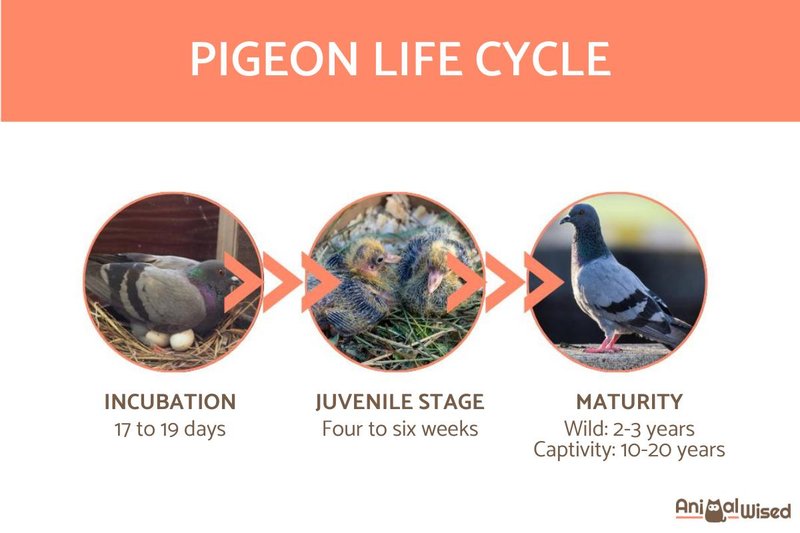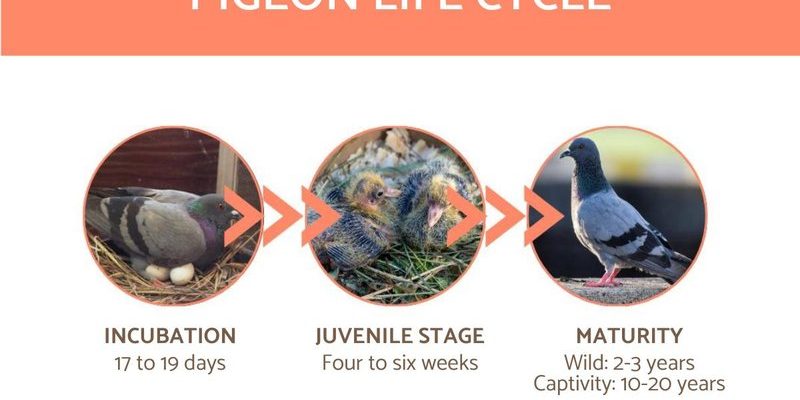
Pigeons, particularly the rock pigeon, have adapted remarkably well to urban environments, which you might find surprising. They’ve turned city buildings and bridges into their homes, embracing the wild side of domestic life. Let’s explore how these feathered friends build their nests, what their lifecycle looks like, and why understanding these habits is essential for both nature enthusiasts and urban dwellers alike.
Where Do Pigeons Nest?
Pigeons are not picky about where they set up shop. Typically, they prefer high places where they can keep an eye out for predators. You might see them nesting on ledges, rooftops, or even in tree branches. These spots provide a sense of security, much like the way you might feel safe in a cozy corner of your favorite coffee shop.
They often choose locations with some shelter from the elements, which is important for keeping their young safe and dry. The ideal nesting site is usually close to a food source, making it easier for the parents to find meals for their chicks. You might wonder why they prefer urban areas—well, it’s all about the abundance of food scraps and safe nesting locations.
Common Nesting Materials
When it comes to building their nests, pigeons are quite resourceful. They typically gather a mix of materials that are easy to find, giving them a unique personal touch. You’ll often see them using:
- Twigs and small branches
- Grass and weeds
- Feathers
- Paper and plastic bits
These materials create a platform that’s soft and comfortable for their chicks. It’s similar to how we might make our beds with soft sheets and cozy blankets—pigeons just have a different style!
The way they weave these items together is quite impressive. This skill helps ensure that their nests are stable and can hold up against wind or rain. Honestly, watching a pigeon gather materials can be like witnessing a little architect at work.
The Nesting Process
Once pigeons have selected a prime location, it’s time to set up the nest. The female pigeon (called a hen) usually takes the lead on this project. After gathering materials, she’ll arrange them into a shallow bowl shape. You might be wondering how long this takes. Typically, it can take anywhere from a few days to a week, depending on how resourceful they are and if they get distracted along the way!
After the nest is built, both parents will take turns sitting on their eggs. This is an important bonding time for them. They’ll frequently coo to each other, a form of communication that helps strengthen their partnership. It’s kind of sweet when you think about it—like they’re saying, “We got this!”
Egg Laying and Incubation
Pigeon eggs are generally laid in pairs, usually two per nesting cycle. The eggs are typically white, resembling tiny little pearls resting in their cozy nest. Once the eggs are laid, both parents will share incubation duties. They take turns keeping the eggs warm, which is crucial for the developing chicks inside.
The incubation period lasts about 17 to 19 days. During this time, the parents need to stay vigilant, protecting their future offspring from potential threats. Did you know that pigeons can recognize their eggs? That’s pretty impressive! They can tell when an egg is missing or if something’s not quite right.
The Chick Stage
Once the eggs hatch, the real work begins. Pigeon chicks, often called squabs, are born blind and featherless, which might look a bit alarming at first. However, they grow quickly, gaining feathers and strength within just a few weeks. This rapid development is crucial for their survival, especially in an urban environment where dangers lurk.
The parents feed their chicks a special substance called “pigeon milk,” a nutritious secretion from the lining of their crops. This unique food is rich in proteins and fats, helping the squabs grow strong. Here’s the thing: pigeons are committed parents, often staying with their young until they’re ready to leave the nest, which usually happens around three to four weeks after hatching.
Fledging and Independence
As the squabs approach the fledging stage, they start to stretch their wings and practice flapping. You might see them wobbling around the nest, testing their newfound skills. This is a normal part of their development. Eventually, they will take their first flight, leaving the nest behind.
However, even after they fly away, they often stick close to their parents for a while, learning the ropes of finding food and avoiding danger. It’s a bit like a teenager learning to drive—lots of practice and a few bumps along the way.
Pigeon Family Dynamics
Pigeons are known for their strong family bonds. You might notice that they often mate for life, creating a tight-knit unit. This partnership not only helps in raising their young but also keeps their nest safe from intruders.
Interestingly, both parents will continue to care for the squabs even after they’ve fledged. They’ll guide them in finding food and shelter, ensuring they have the skills needed to survive in the wild. This supportive environment helps prepare the young pigeons for their future lives, which may include finding mates and starting their own families.
Urban vs. Rural Nesting Habits
You may be curious about how urban pigeons differ from their rural counterparts. Urban pigeons tend to have a more flexible lifestyle due to the constant availability of food and shelter. In contrast, rural pigeons might have to work a bit harder to find suitable nesting spots and food sources.
However, in both scenarios, the core nesting habits remain the same. Pigeons are resourceful and adaptable, showcasing their ability to thrive, whether in the bustling city or the serene countryside. Both environments offer unique challenges, but pigeons have evolved to handle them with ease.
Why Understanding Pigeon Nesting Habits Matters
Now that you’ve dived into the world of pigeon nesting habits and their lifecycle, you might wonder why it matters. For many, observing pigeons can spark a deeper appreciation for nature, even in the heart of the city. Knowing how they live and raise their young can help us foster a respectful coexistence with these birds.
Pigeons play a vital role in many ecosystems, contributing to seed dispersal and serving as prey for various predators. By understanding their nesting habits, we can work to protect their habitats and ensure they continue to thrive. After all, every species has a unique place in our world, and pigeons are no exception.
In summary, pigeons might seem ordinary at first glance, but their nesting habits reveal a rich tapestry of behaviors and family dynamics. By taking the time to understand their lifecycle, we can better appreciate these clever birds that have adapted to our urban landscapes. Whether you view them as a nuisance or a delightful part of the city, there’s no denying they have their own story to tell. So, next time you see a pigeon, take a moment to consider the little life drama unfolding just outside your window.

